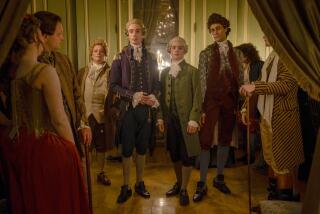He dresses up history and his students like the fit
- Share via
The students in Chuck Olynyk’s world history class will learn about the Hundred Years’ War by helping him dress for it.
It’s not unusual for their teacher to bound around his room at Roosevelt High School — or the “O-zone,” as it’s known — wearing armor made of aluminum or a puffy tunic as he takes his students on a journey through history.
But even for Olynyk, this day is a little different. For one, he tells his students not to bother taking notes. None of this lesson will show up on a test — it’s “enrichment,” he says. He wants to show them that the uniform of a knight isn’t what they see in the movies: easy to maneuver or even remotely comfortable. It’s hot, it’s heavy, it’s stinky, and it makes whoever is wearing it walk with the stiff-jointed gait of RoboCop.
He asks for volunteers. A few boys come up and assist him as a couple of girls snicker off to the side.
They put on the coat with chain mail and tie the aluminum plates onto his torso. When it comes to the neck brace, he warns them to be careful — a student in an earlier period put it on so tight it “nearly snapped my head like a zit,” he said. (“I don’t have a neck!” he told them. “We have to pretend I have a neck!”)
Within minutes, they had transformed their teacher into a knight.
Olynyk, a veteran teacher, has amassed a wardrobe spanning ancient Greece to the end of the 19th century. He often spends more than $2,000 a year on his classroom, mostly on the costumes and props central to his lessons. He creates most of them himself, or they’re given to him by friends. The armor plates, for instance, were homemade, and the knight’s helmet was inherited from a friend.
“It’s awkward for me to move in. I have to plan my bathroom breaks,” he said, complaining about the period wear. But he wouldn’t have it any other way. He think it makes a difference, encouraging his students to become engaged with distant times and connect their own lives with history.
Olynyk, in his second year at Roosevelt after many years at Fremont High School, has a theory: 10th grade is about the time a number of students decide if they are going to drop out. He’s betting that if he can get them to like just one class — his — what will stop them from getting involved in another, and maybe just hanging around?
Esteban Lopez, a longtime teacher at Roosevelt and Olynyk’s teaching partner last year, said educators have to find ways to keep their students’ attention. “This is a school that no longer has electives or the fun things,” said Lopez, an 11th-grade English instructor who favors button-down shirts and ties.
Dressing up “is another thing a teacher can do to catch them or try to engage them.”
Olynyk sees himself in his students. Like many of them, he’s the child of immigrants; his Ukrainian parents didn’t speak English well and couldn’t give him all the educational support he needed at home. “I am not willing to let their reading ability or a lack of a language ability stand in the way,” he said.
Students have gravitated toward him. Members of the drill team stow their bags in his room, and students hit him up for fundraisers. He even shows up at football games — dressed, of course, as one of Theodore Roosevelt’s Rough Riders (the school’s nickname).
In the classroom, it appears his concept has worked. Students say his class isn’t as boring as others, and they can venture through history with Olynyk’s costume as a point of reference.
“It’s cool, it grabs your attention,” said Claudia Espinoza. “It makes you actually want to learn, because you see it.”
Griselda Avalos said her favorite was when Olynyk dressed as an old-school gangster, which she thought was for the lesson on medieval times.
But Juan Herrera corrected her. It was the Renaissance.
Al Lewis, principal of the humanities and arts school on the Boyle Heights campus, said Olynyk didn’t come to his job interview in a period costume, but he did show up with a portfolio of photos. Although the costumes are catchy, Lewis has found that Olynyk’s success in reaching students has to do with much more than what he wears.
Beneath the coat of armor and his wicked sense of humor, Lewis said, is a good teacher who cares deeply about his students and whether they learn.
“A suit of armor,” Lewis said, “only gets you so far.”
More to Read
Sign up for Essential California
The most important California stories and recommendations in your inbox every morning.
You may occasionally receive promotional content from the Los Angeles Times.









